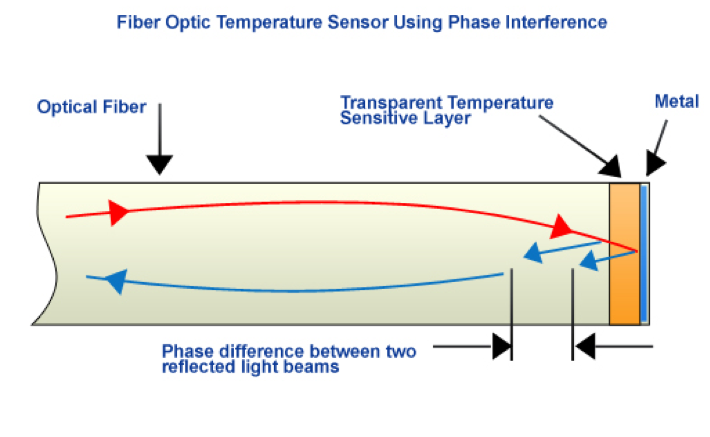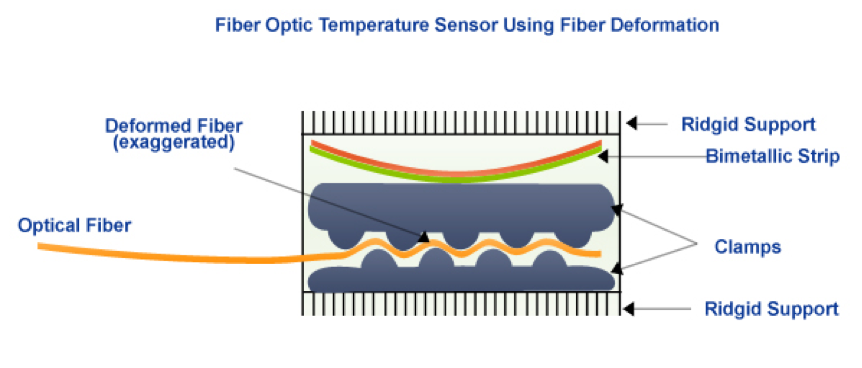What Types of Fiber Optic Sensing Technologies are Available?
There are many technologies, but commercial solutions really boil down to two main categories: point sensing for which the active portion of the fiber is <= 1cm, and distributed sensing where the entire fiber, perhaps tens of kilometers long, is the sensor.
Fiber optic distributed sensors measure temperature only (Raman Optical Time Domain Reflectometry - ROTDR) or both strain and temperature (Brillioun Optical Time Domain Reflectometry - BOTDR). Spatial resolution is typically one meter or more and strain and temperature resolution are reported at about one microstrain and one degree C respectively, with sampling rates of a few seconds per measurement. The beauty of these approaches is that standard (i.e., inexpensive) telecom fiber is the sensor. The fiber is usually packaged in a tough outer jacket for deployment. Instrumentation is often US$100,000 or more, however. But still the value is very good for long range (>2 km) applications such as pipelines, tunnels, power transmission lines.
Fiber optic point sensors are found in two basic types: fiber Bragg grating (FBG) sensors and Fabry-Perot (FP) sensors. FP sensors have found an important niche in measuring strain, temperature, and particularly pressure for medical applications. They are very small (especially the pressure sensors), but only one sensor can be used per fiber.
FBG sensors for strain and temperature are also very small sensor as short as 2mm in a 150 micron fiber diameter or as long as a few meters for long gauge strain measurements. Other properties like pressure, acceleration, displacement, humidity, and chemical presence, are measured by using a transducer to relate strain to pressure or strain to acceleration, for example. A key advantage of FBG sensors is that dozens, or even a hundred, can be used in series on a single fiber - even if they are measuring different physical properties.
Fiber Bragg grating technology is by far the most widely used fiber optic sensor technology. The versatility of the technology and relatively low cost make it a winner for many applications. At Micron Optics, well over 90% of our sensing customers use FBG based sensors. Whether they are examining a cancer patient, monitoring a bridge, flying an airplane or pumping oil, they need the information that Micron Optics technology can glean from fundamental measurements of FBGs.
Fiber Optic Temperature Sensors
“The group of sensors known as fiber optic thermometers generally refers to those devices measuring higher temperatures wherein blackbody radiation physics are utilized.” Fiber optic thermometers or fiber optic temperature sensors are basically light pipes which are mainly employed for measurement of temperature in complex situations. They are solely constructed of thin glass fibers. They make use of the same type of fiber which is used in communication systems. There are basically two approaches by means of which one can easily measure temperature. They are:
Using Phase Interference: Fiber optic temperature measurement using this technique is shown in the figure below. In this, the material used for temperature sensing is applied directly on the cleaved portion of the optical fiber. A transparent temperature sensitive layer is also present there. Hence, the incoming light will be reflected back in two parts. By measuring the phase difference between two reflected beams of light, one can easily determine temperature.

Using Fiber Deformation: Another way is to employ a conventional temperature sensing mechanism like bimetallic strip as shown in figure for creating deformation of the optical fiber. This deformation or bending of the fiber must be adequate to produce a considerable difference.

Main Characteristics
Optical fibers are employed for measurement of temperature owing to their following characteristics:
l They exhibit micro bending and interferometric effects.
l They undergo change in index of refraction and length of fiber.
l They demonstrate change in polarization and fiber diffraction grating effects.
l They experience Sagnac effect too in which light usually travels around a loop in different directions which can then be used to detect rotation.
Advantages
Optical fibers are frequently employed for communications and industrial temperature measurements because of their ability to withstand harsh and intricate environmental conditions. Some of the major benefits offered by them are mentioned below:
l They are impervious to electromagnetic interferences generated from electric motors, transformers and welders etc.
l Also, they are not influenced by radio frequency interferences caused due to wireless communication technology and lightning action.
l They can be easily installed in areas which are difficult to reach or inspect.
l They can be applied for measurement of temperature in very small and specific areas.
l Optical fiber cables never conduct electricity hence they are considered appropriate for locations which are likely to explode.
l Optical fibers can be conveniently placed in existing conduit and cable trays or tied to beams, pipes or conduit. Hence, they are widely applied in areas requiring expansions or retrofits
l Moreover, they are capable enough to deal with ambient temperatures beyond 300°C. This temperature range can be increased further with air or water purging.
Applications
Optical fibers mainly find their use in following areas:
l They are widely employed for sensing temperature in hazardous and unsafe regions.
l Also, they are applied in situations where use of conventional temperature sensors is not feasible. For instance, temperature measurement of windings of high voltage oil cooled power transformer whose peak voltage is around 500kV. In these conditions, use of wired sensors can prove dangerous to the health of the person handling measuring device. Besides, non-contact sensors cannot be employed since the windings are enclosed within the transformer and not traceable. Hence, the use of fiber optic temperature sensors turns out to be the obvious and only choice left to deal with these situations.
l They are very helpful for temperature measurements in case of basic metals and glass productions. Moreover, they can be employed in the preliminary hot forming methods for these materials.
l In power generation field, they are normally employed for temperature measurement in Boiler burner flames or tubes and vital turbine areas.
l They are also installed in fabricated metal plant areas, for example rolling lines in steel etc. due to their ability to put up with ruthless conditions present in these areas.
l They are also employed in the semiconductor industries for activities involving fusion, sputtering, and crystal growth.
l Advanced techniques have been developed for doping of fiber optics which would enable them to work directly as radiation emitters at hot spots. In this way they will operate as the sensing device and the media as well.
l Other typical applications of fiber optic temperature sensors include:
l All kinds of furnaces
l Sintering processes
l Ovens and kilns
l Automated welding operations
l Processing actions in cement, refractory and chemical industries involving high temperatures
l Plastics processing, paper making and food processing activities involving low temperatures
l Brazing and annealing equipments producing heavy electrical disturbances
Fiber optic sensors offer complete immunity to RF and microwave radiation with high temperature operating capability, sothey can be used for measurement on patients and materials in magnetic resonance scanner (MRI). Metallic sensors can breed errors at the image acquisition. For special cancer treatment sensorswith a diameter of 0,5 mm are available. These can be used minimal invasive for monitoring of tissue temperature. Another application of fiber optical measurement technique is laser therapy. Through an endoscope laser energy is coupled and the temperature will be measured via a fiber optic probe at the location of therapy.
Environmental
Industrial areas are often contaminated of the soil by oil, toxic and persistent organic compounds. To clear this fields a soil heating by radio waves is frequently used. Fiber optical sensors are deployed to monitoring and controlling this process. A high- power generator will deliver energy in radio frequency range. The polluted soil is covered with electrodes, which will heat the surface dielectric. Besides, several fiber optical probes are put in the soil. Depending on the measured value different values of temperature and temperature distribution can be realized in the soil. Depending on the level of contamination the temperature will be increased slightly to activate a higher decomposition of soil organisms, alternatively the soil water will condensate in a temperature range up to 150°Celsius together with non-steam resistant organic contaminations. A perforated soil air extraction system takes the steams away and recirculates them into a filter system.
Chemical and Petrochemical Environments
Fiber optic temperature probes are designed to withstand harsh and corrosive environments. The sensors are intrinsically safe. There are no components which create sparks, leading to explosions. They consist of completely non-conductive components and can therefore be used in hazardous areas. They can have a length up to 2.5 miles, so that the analysis can be placed outside the hazardous area.
Microwave and Radiofrequency Environments
In microwave heated installations chemical digestion under pressure and temperature for the determination of trace and ultra-trace analysis in downstream processes will be executed, for that reason it was found that under certain pressure and temperature conditions, the yield or efficiency of extraction or digestion processes could be significantly improved. So fiber optical temperature sensors are the only way to control temperatures in microwave chemistry.
Generator and Transformer
The claims of a modern society relating to electricity requirement approach the full capacity of the generating stations. To ensure industrial safety the temperature must be tightly controlled. High power generators are often filled with hydrogen in order to cool effectively. Besides the heavily contaminated electromagnetic environment the risk for explosions is high. Only fiber optical thermometer can be used for measurement in this areas.
Wood Drying
In the renovation of wooden structures can control the core temperature of the wood on a fiber-optic temperature probe beams in place. The thermal drying of wood components in the installed state between 80 and 95°C is sufficient to effect the dry rot infestation to combat and prevent damage. The probes used for temperature measurement consist of a jacketed with PTFE glass fiber at the fiber tip with a GaAs crystal(Gallium arsenide) and is completely non-metallic are.
Electric Motors
In the industry, the machinery and equipment is increasing to the limits of their strength exhausted. An engine with a larger or smaller size can be used to gain or loss of a job lead. On the consumer side as well on a high mileage engine value set. Fiber optic temperature measurements without external effects (magnetic fields, radio frequencies, microwaves) can work quickly and easily even in hazardous areas. They can used easily to measure the stator winding temperature of an engine or the bearing temperature. The sensors help to detect temperature changes quickly to report the fact to initiate preventive measures.
Fiber Optic Temperature Measuring System
The construction of a typical fiber optic probe is shown in the figure below. By stimulating a variety of sensing materials like phosphors, semiconductors or liquid crystals via fiber optic links, one can easily measure target temperatures which fall in the range of 100°C to 400°C. “An activated temperature measuring system involves a sensing head containing a luminescing phosphor attached at the tip of an optical fiber. A pulsed light source from the instrument package excites the phosphor to luminescence and the decay rate of the luminescence is dependent on the temperature.” This type of arrangement will perform suitably for targets having non-glowing heated surfaces with temperature not more than 400°C.





